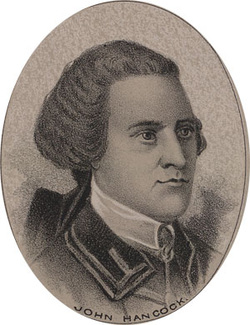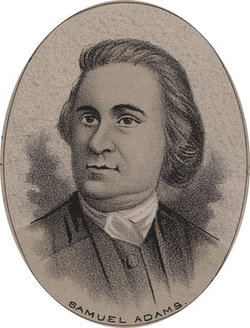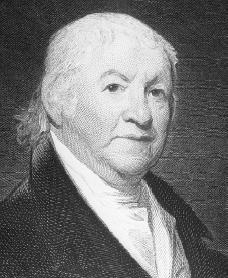John Hancock

Born:January 12, 1737 Birthplace:Braintree (Quincy), Mass. Education:Graduated Harvard College (Merchant.) Work:Elected to the Boston Assembly, 1766; Delegate to, and President of, the Provincial Congress of Massachusetts, circa 1773; Elected to Continental Congress, 1774; Elected President of the Continental Congress, 1775; Member of Massachusetts state Constitutional Convention, elected Governor of Massachusetts, through 1793. Died:October 8, 1793 The signature of John Hancock on the Declaration of Independence is the most flamboyant and easily recognizable of all. It is perhaps no surprise that the story of his part in the revolution is equally engaging. Few figures were more well known or more popular than John Hancock.
He played an instrumental role, sometimes by accident, and other times by design, in coaxing the American Revolution into being.
Born in Braintree, Massachusetts in 1737, he was orphaned as a child, and adopted by a wealthy merchant uncle who was childless. Hancock attended Harvard College for a business education and graduated at the age of 17. He apprenticed to his uncle as a clerk and proved so honest and capable that, in 1760, he was sent on a business mission to England.
There he witnessed the coronation of George III and engaged some of the leading businessmen of London. In 1763, his uncle died and John Hancock inherited what was said to be the greatest body of wealth in New England.
This placed him in a society of men who consisted mainly of loyalists, suspected by the working population because of their great affluence and social power.
Hancock, however, soon became very involved in revolutionary politics and his sentiments were, early on and clearly, for independence from Great Britain.
He was in company with the Adamses and other prominent leaders in the republican movement in New England. He was elected to the Boston Assembly in 1766, and was a member of the Stamp Act Congress.
In 1768 his sloop Liberty was impounded by customs officials at Boston Harbor, on a charge of running contraband goods. A large group of private citizens stormed the customs post, burned the government boat, and beat the officers, causing them to seek refuge on a ship off shore. Soon afterward, Hancock abetted the Boston Tea Party.
The following year he delivered a public address to a large crowd in Boston, commemorating the Boston Massacre. In 1774, he was elected to the Provincial Congress of Massachusetts and simultaneously to the Continental Congress. When Peyton Randolph resigned in 1776, Hancock assumed the position of President. He retired in 1777 due to problems with gout, but continued public service in his native state by participating in the formation of its constitution. He was then elected to the Governorship of the state where he served for five years, declined reelection, and was again elected in 1787. He served in that office until his death in 1793. The dignity and character of John Hancock, celebrated by friend and enemy alike, did not suffer for his love of public attention. He was a populist in every sense, who held great confidence in the ability of the common man. He also displayed a pronounced contempt for unreasoned authority. A decree had been delivered from England in early 1776 offering a large reward for the capture of several leading figures. Hancock was one of them.
The story, entirely unfounded, is that on signing the Declaration, Hancock commented, "The British ministry can read that name without spectacles; let them double their reward." An alternate story, also unfounded has him saying, "There, I guess King George will be able to read that!" He was the first to sign and he did so in an entirely blank space.
Information from www.ushistory.org
He played an instrumental role, sometimes by accident, and other times by design, in coaxing the American Revolution into being.
Born in Braintree, Massachusetts in 1737, he was orphaned as a child, and adopted by a wealthy merchant uncle who was childless. Hancock attended Harvard College for a business education and graduated at the age of 17. He apprenticed to his uncle as a clerk and proved so honest and capable that, in 1760, he was sent on a business mission to England.
There he witnessed the coronation of George III and engaged some of the leading businessmen of London. In 1763, his uncle died and John Hancock inherited what was said to be the greatest body of wealth in New England.
This placed him in a society of men who consisted mainly of loyalists, suspected by the working population because of their great affluence and social power.
Hancock, however, soon became very involved in revolutionary politics and his sentiments were, early on and clearly, for independence from Great Britain.
He was in company with the Adamses and other prominent leaders in the republican movement in New England. He was elected to the Boston Assembly in 1766, and was a member of the Stamp Act Congress.
In 1768 his sloop Liberty was impounded by customs officials at Boston Harbor, on a charge of running contraband goods. A large group of private citizens stormed the customs post, burned the government boat, and beat the officers, causing them to seek refuge on a ship off shore. Soon afterward, Hancock abetted the Boston Tea Party.
The following year he delivered a public address to a large crowd in Boston, commemorating the Boston Massacre. In 1774, he was elected to the Provincial Congress of Massachusetts and simultaneously to the Continental Congress. When Peyton Randolph resigned in 1776, Hancock assumed the position of President. He retired in 1777 due to problems with gout, but continued public service in his native state by participating in the formation of its constitution. He was then elected to the Governorship of the state where he served for five years, declined reelection, and was again elected in 1787. He served in that office until his death in 1793. The dignity and character of John Hancock, celebrated by friend and enemy alike, did not suffer for his love of public attention. He was a populist in every sense, who held great confidence in the ability of the common man. He also displayed a pronounced contempt for unreasoned authority. A decree had been delivered from England in early 1776 offering a large reward for the capture of several leading figures. Hancock was one of them.
The story, entirely unfounded, is that on signing the Declaration, Hancock commented, "The British ministry can read that name without spectacles; let them double their reward." An alternate story, also unfounded has him saying, "There, I guess King George will be able to read that!" He was the first to sign and he did so in an entirely blank space.
Information from www.ushistory.org
Samuel Adams

Born:September 27, 1722 Birthplace:Boston, Mass. Education:Master of Arts, Harvard. (Politician) Work:Tax-collector; Elected to Massachusetts Assembly, 1765; Delegate to the First Continental Congress, 1774; Signed Declaration of Independence, 1776; Member of Massachusetts State constitutional convention, 1781; Appointed Lieutenant Governor of Mass., 1789; Elected Governor of Massachusetts, 1794-'97. Died:October 2, 1803 Samuel and John Adams' names are almost synonymous in all accounts of the Revolution that grew, largely, out of Boston. Though they were cousins and not brothers, they were often referred to as the Adams' brothers, or simply as the Adams'. Samuel Adams was born in Boston, son of a merchant and brewer. He was an excellent politician, an unsuccessful brewer, and a poor businessman. His early public office as a tax collector might have made him suspect as an agent of British authority, however he made good use of his understanding of the tax codes and wide acquaintance with the merchants of Boston. Samuel was a very visible popular leader who, along with John, spent a great deal of time in the public eye agitating for resistance. In 1765 he was elected to the Massachusetts Assembly where he served as clerk for many years. It was there that he was the first to propose a continental congress. He was a leading advocate of republicanism and a good friend of Tom Paine. In 1774, he was chosen to be a member of the provincial council during the crisis in Boston. He was then appointed as a representative to the Continental Congress, where he was most noted for his oratory skills, and as a passionate advocate of independence from Britain. In 1776, as a delegate to the Continental Congress, he signed the Declaration of Independence. Adams retired from the Congress in 1781 and returned to Massachusetts to become a leading member of that state's convention to form a constitution. In 1789 he was appointed lieutenant governor of the state. In 1794 he was elected Governor, and was re-elected annually until 1797 when he retired for health reasons. He died in the morning of October 2, 1803, in his home town of Boston.
Information from www.ushistory.org
Information from www.ushistory.org
Paul Revere

Born: January 1, 1735
Boston, Massachusetts
Died: May 10, 1818
Boston, Massachusetts
American patriot, silversmith, and engraver
Read more: Paul Revere Biography - life, family, children, name, school, mother, young, son, information, born http://www.notablebiographies.com/Pu-Ro/Revere-Paul.html#ixzz1Y7UFLjxG
Boston, Massachusetts
Died: May 10, 1818
Boston, Massachusetts
American patriot, silversmith, and engraver
Read more: Paul Revere Biography - life, family, children, name, school, mother, young, son, information, born http://www.notablebiographies.com/Pu-Ro/Revere-Paul.html#ixzz1Y7UFLjxG
